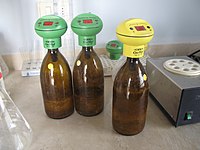
Photo from wikipedia
Anthropogenic activities have drastically affected the environment, leading to increased waste accumulation in atmospheric bodies, including water. Wastewater treatment is an energy-consuming process and typically requires thousands of kilowatt hours… Click to show full abstract
Anthropogenic activities have drastically affected the environment, leading to increased waste accumulation in atmospheric bodies, including water. Wastewater treatment is an energy-consuming process and typically requires thousands of kilowatt hours of energy. This enormous energy demand can be fulfilled by utilizing the microbial electrolysis route to breakdown organic pollutants in wastewater which produces clean water and biohydrogen as a by-product of the reaction. Microalgae are the promising microorganism for the biohydrogen production, and it has been investigated that the interaction between microalgae and bacteria can be used to boost the yield of biohydrogen. Consortium of algae and bacteria resulting around 50-60% more biohydrogen production compared to the biohydrogen production of algae and bacteria separately. This review summarises the recent development in different microalgae-bacteria granular consortium systems successfully employed for biohydrogen generation. We also discuss the limitations in biohydrogen production and factors affecting its production from wastewater.
Journal Title: Bioresource technology
Year Published: 2022
Link to full text (if available)
Share on Social Media: Sign Up to like & get
recommendations!